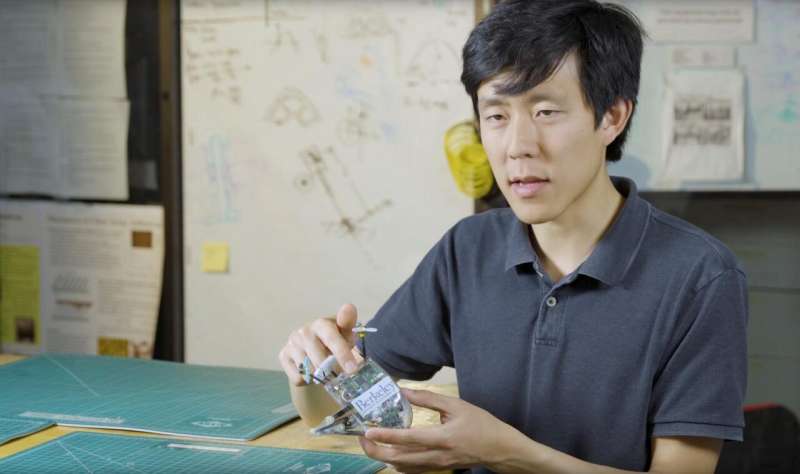Army project develops agile scouting robots

In a research project for the U.S. Army, researchers at the University of California, Berkeley developed an agile robot, called Salto that looks like a Star Wars Imperial walker in miniature and may be able to aid in scouting and search-and-rescue operations.
Robots like this may one day be used to save lives of both warfighters and civilians, researchers said.
Topping out at less than a foot, Salto, which stands for saltatorial (leaping like a grasshopper) locomotion on terrain obstacles, now has a sophisticated control systems that allows it to master increasingly complex tasks, like bouncing in place, navigating an obstacle course or following a moving target, all controlled with a radio controller.
In 2016, the research team demonstrated how Salto could take a leap and then immediately spring higher by ricocheting off a wall, making it the world's most vertically agile robot—jumping for than three times its height.
With its new capabilities, the researchers hope Salto will propel the development of small, nimble robots that could leap through rubble to aid in search-and-rescue and other military missions.
"The physical environment the Army operates in is highly irregular, cluttered, and constantly changing," said Dr. Samuel Stanton, program manager at Army Research Office, an element of U.S. Army Combat Capability Development Command's Army Research Laboratory. "The science underlying the advancements is critical for achieving the desired mobility, speed of action, and situational awareness generation necessary for future Army operations."
The research team described the robot's new skills at the 2019 International Conference on Robotics and Automation in Montreal May 21.
"Small robots are really great for a lot of things, like running around in places where larger robots or humans can't fit. For example, in a disaster scenario, where people might be trapped under rubble, robots might be really useful at finding the people in a way that is not dangerous to rescuers and might even be faster than rescuers could have done unaided," said UC Berkeley robotics graduate student Justin Yim. "We wanted Salto to not only be small, but also able to jump really high and really quickly so that it could navigate these difficult places."
Yim works with Ronald Fearing, an electrical engineering and computer sciences professor at UC Berkeley, whose Biomimetic Millisystems Lab explores how the mechanics of animal movement can be applied to create more agile robots.
Fearing's lab is known for building insect-inspired robots that can safely crawl across tricky surfaces that are too smooth or too rough for a wheeled robot to navigate.
Salto's single, powerful leg is modeled after those of the galago, or Senegalese bush baby. The small, tree-dwelling primate's muscles and tendons store energy in a way that gives the spry creature the ability to string together multiple jumps in a matter of seconds. By linking a series of quick jumps, Salto also can navigate complex terrain—like a pile of debris—that might be impossible to cross without jumping or flying.
"Unlike a grasshopper or cricket that winds up and gives one jump, we're looking at a mechanism where it can jump, jump, jump, jump," Fearing said. "This allows our robot to jump from location to location, which then gives it the ability to temporarily land on surfaces that we might not be able to perch on."
Yim has also equipped Salto with new technology that allows it to feel its own body, telling it what angle it is pointing and the bend of its leg. Without these abilities, Salto has been confined to a room in one of Berkeley's engineering buildings, where motion capture cameras track its exact angle and position and transmit that data back to a computer, which rapidly crunches the numbers to tell Salto how to angle itself for its next leap.
Now that Salto has a sense of itself and its own motion, the robot can make these calculations for itself, allowing Yim to take the robot outside and use a joystick and radio controller to tell it where to go.
"By understanding the way that these dynamics work for Salto, with its mass and size, then we can extend the same type of understanding to other systems, and we could build other robots that are bigger or smaller or differently shaped or weighted," Yim said.
In the future, Fearing hopes to continue to explore the possibilities for hopping robots.
"This Army investment extends the current state of the art for small ground robot mobility beyond what is currently capable through traditional wheeled and tracked locomotion which are severely limited in complex three-dimensional terrain," said Dr. Brett Piekarski, Vehicle Technology Directorate, ARL. "These advances will inform and guide our Army Research Laboratory researchers as they continue to develop innovative solutions for robotic actuation and mobility and will enable agile robots that can go anywhere a Soldier can and beyond. This research brings us a step closer to providing our warfighters with effective unmanned systems that can be deployed in the field."
Provided by The Army Research Laboratory





















